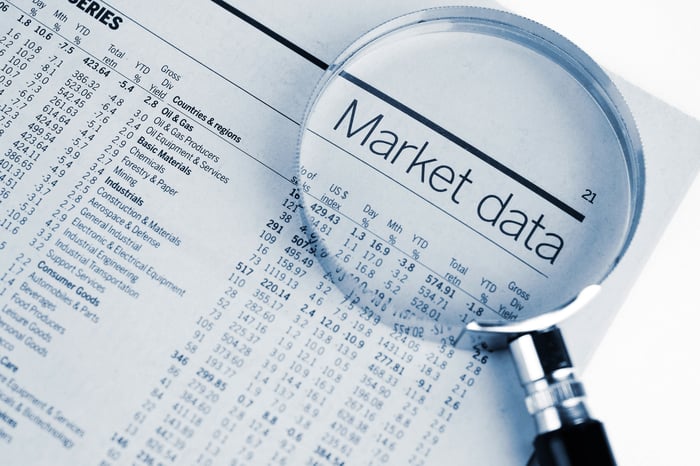In case you haven't noticed, the stock market is having one of its best starts to the new year in a very long time. According to data from Bespoke, courtesy of CNBC, the broad-based S&P 500 (^GSPC 0.87%), the most-encompassing measure of stock market and economic health in the United States, has historically averaged a 2.2% gain in the first quarter. But through the end of March 2019, the S&P 500 had logged a 13.1% gain.
Best of all, things haven't slowed in April, either. Nearly a fifth of the S&P 500 stocks (94 companies in total) have seen their share prices rise by at least 30% year to date through April 23.
More important of all, though, the S&P 500 came full circle on Tuesday. Although it failed to surpass its all-time intraday high of almost 2,941, it recorded its highest close in history at 2,933.68.

Image source: Getty Images.
Long-term investors are still batting 1.000
For those who may recall, the stock market underwent its steepest correction since the Great Recession during the fourth quarter of 2018. The S&P 500 wound up declining 19.8% from peak to trough over a 95-calendar-day period, courtesy of data from Yardeni Research, just missing out on the first bear market since early 2009, based on closing values. But with its ascent to a new closing high on Tuesday, the S&P 500 did something that's been done only 37 times since the beginning of 1950: It completely erased a stock market correction.
Stock market corrections themselves are actually far more common than you realize. If we were to only count those corrections that hit at least 10% since 1950 (i.e., no rounding-up allowed), we'd see a bona fide correction, on average, every 1.89 years. Understandably, the stock market doesn't follow averages, even if market pundits would like to typecast the market into doing so. Sometimes we can go years without a correction, whereas in 2018 we saw two within a reasonably short time frame.
And while corrections are common, they also don't tend to last very long. In total, 23 of the past 37 corrections have found their bottom in 104 or fewer calendar days, with just two corrections lasting longer than 288 days since 1982. This, in turn, means that the stock market has spent the vast majority of its time rallying or treading water since 1950, which is good news for investors with a long-term horizon.

Image source: Getty Images.
Data also backs up the thesis that remaining long during even the most turbulent times is investors' smartest move. According to the Get Invested, Stay Invested: Navigating Volatile Markets report from J.P. Morgan Asset Management, an investor in the S&P 500 who stayed the course for 20 years, between Jan. 1, 1998, and Dec. 29, 2017, would have earned a 7.2% average annual return.
Mind you, this period includes the two largest declines in the stock market since the Great Depression (the dot-com bubble and Great Recession). But if you had tried to time the market and missed even the 10 best days, your return was essentially halved. Since many of the stock market's best days occur within days or weeks of its worst days, rolling the dice by trying to time the market simply isn't worth it.
Long-term investors are a perfect 37-for-37 with regard to putting corrections in the rearview mirror over the last 70 years (and really since the inception of the stock market). So, while you're probably thinking that the stock market has come too far, too fast in 2019, understand that in perhaps three months, three years, or 30 years, you'll be looking back and wondering why you didn't just continue to buy anytime you had spare money to do so.
Psst, you can still find bargains, even with the stock market at a new high
However, if you are intent on nabbing value, it does still exist, even with the stock market at a new closing high.
For example, retail drugstores are currently trading at their lowest forward price-to-earnings ratio in at least 22 years (that's as far back as Yardeni Research's available data goes). Companies like CVS Health (CVS -0.17%) have been beaten to a pulp as competition has picked up, Medicare-for-All discussions have taken shape among select Democratic presidential candidates, and generic-drug price weakness has hurt pharmaceutical margins.

Image source: CVS Health.
But CVS Health has gone on the offensive by acquiring health insurance giant Aetna, thereby bringing tens of millions of members into the fold whom it can potentially keep within its prescription network. The buyout should also result in ample cost savings ($750 million annually by next year) and stronger organic growth. At only seven times next year's earnings per share, CVS Health offers plenty of value.
Similarly, the forward P/E ratio of biotech stocks is bordering on an all-time low. Traditionally known for their boom-or-bust nature, biotech companies like Jazz Pharmaceuticals (JAZZ -1.01%) are incredibly inexpensive, albeit sometimes overly reliant on a single drug. At less than 8 times forward earnings, Jazz, which focuses on sleep disorder and specialty therapies, should raise some eyebrows. Net sales of lead drug Xyrem soared another 18% in 2018 to $1.4 billion, with acute myeloid leukemia drug Vyxeos hitting $100 million in net sales, tripling up what it produced in 2017. Though generic entrants are always a threat for specialty drug producers, Jazz has been able to protect its core branded drug like a champ.
The point being that there are plenty of ways even skeptical or value-minded investors can average into the stock market right now, even with the S&P 500 at an all-time high. As long as you're willing to give your investments an appropriate amount of time to execute on their long-term growth strategy, the data suggests you have a very good chance to make money.




